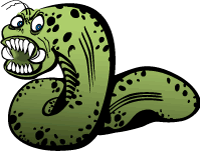Drawn Pasteur pipette
Materials:
- Pasteur pipette
- Bunsen Burner
Procedure:
The purpose of the drawn Pasteur pipette is to create a much smaller opening, allowing for more dexterous use. (Figure 1) This is extremely useful for asperating minute volumes of liquid, as with DAPI staining.
- Hold the Pasteur pipette so that the flame of the Bunsen burner heats a spot about 2/3 down the length of the thin tube. Lower the pipette into the flame just above the blue cone. It will glow orange and become soft. (Figure 2 )
- As soon as the glass softens, quickly pull the ends of the pipette away from each other. (Figure 3 ) The resultant drawn pipette should be, ideally, as straight as possible.
- Optional: If the resultant drawn pipette sealed itself in the flame or is slightly curly, you can use the other piece of the pipette to break off the closed tip and open it up.
- Attach a rubber bulb and use it like you would with any other Pasteur pipette.
Figures
Figure 1.
Different bore size: drawn pipette (left) and regular Pasteur pipette (right)
Figure 2.
The flame should hit the pipette 2/3 of the way down the tube.
Figure 3.
Once the glass softens, quickly pull the pipette apart.




